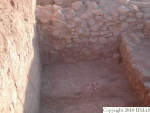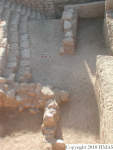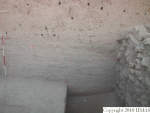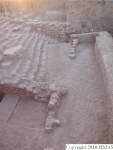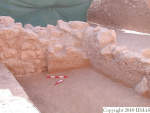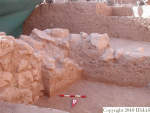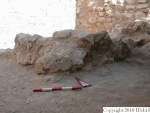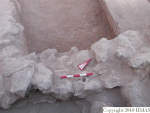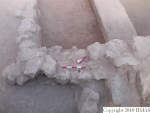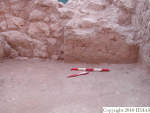1. OVERVIEW
| Roster | Date | Author | Record |
|---|---|---|---|
| Included in other label | 2010-12-03 | cJC | ^use1 (use area) [Input: T914CJC.j] |
| Category | !! | !! | buildup |
| Best definition | 2005-08-19 | vVE | accumulation B [Input: P913MH.j] |
| Best image | 2008-03-06 | pC | 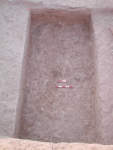 v92 [Input: S206PC.j] |
2. IDENTIFICATION
Designation
| Roster | Date | Author | Record |
|---|---|---|---|
| Description (summary) | 2005-08-20 | vVE | f200 is much more ashy than the overlying layers. [Input: P820VVE1.j] |
| 2005-08-22 | sC | f200 is a natural accumulation in the northern half of k14. It is characterized by a very fine texture (clayish) and it is soft in consistence. When wet it is a bit plastic, and when dry it leaves color on the finger. It is dark brown in color. It is the same of f171 in k13, f174 in k101 and f150 in k4. [Input: P822SC.j] |
3. STRATIGRAPHY
Recovery/Assignment
| Roster | Date | Author | Record |
|---|---|---|---|
| Strategy (projected or implemented) | 2005-08-20 | vVE | Excavation of the northern half of k14 continued today with the start of a new feature: f200. [Input: P820VVE1.j] |
| Procedures | 2005-08-22 | sC | on the P819 the elevator is located in the southern half of k14, therefore is not possible to dig in this area [Input: P822SC.j] |
| Problems in recording | 2008-03-06 | pC | f200 is a feature with many other features: it is 60 cm thick and it covers wall f224 and abuts wall f188: this feature follows not the real stratigraphic sequence: at the top is an ashy accumulation same as f171,f174, f150, then is a graysh soft accumulation [Input: S306PC.j] |
Volumetric Localization
| Roster | Date | Author | Record |
|---|---|---|---|
| Locus | 2005-08-19 | vVE | k14 [Input: P913MH.j] |
| M#/elev @top | 2005-08-19 | vVE | 8868 [Input: P913MH.j] |
| M#/elev @bottom | 2005-08-19 | vVE | 8903 [Input: P913MH.j] |
Contact Association
| Roster | Date | Author | Record |
|---|---|---|---|
| Type of contact: latest events | 2008-03-12 | pC | f269 (accumulation D) rests on f200 (accumulation B) [Input: S211PC2.j] |
| 2008-03-12 | pC | f197 (accumulation D) overlays f200 (accumulation B) [Input: S211PC2.j] | |
| 2008-03-12 | pC | f198 (lens type b) overlays f200 (accumulation B) [Input: S211PC2.j] | |
| Type of contact: contemporary events/movable items | 2005-08-29 | !! | q668.1 (lithic artifact) sits in f200 (accumulation B) [Input: P910MH.j] |
| 2005-08-20 | vVE | q536 (bones, pottery) sits in f200 (accumulation B) [Input: P908MH2.j] | |
| 2005-08-28 | aA | q652 (pottery) sits in f200 (accumulation B) [Input: P908MH2.j] | |
| 2005-08-28 | aA | q653 (pottery) sits in f200 (accumulation B) [Input: P908MH2.j] | |
| 2005-08-28 | aA | q661 (bones, pottery) sits in f200 (accumulation B) [Input: P908MH2.j] | |
| 2005-08-28 | aA | q663 (bones, pottery) sits in f200 (accumulation B) [Input: P908MH2.j] | |
| 2005-08-29 | mH | q668 (pottery) sits in f200 (accumulation B) [Input: P910MH.j] | |
| 2005-08-29 | sC | q673 (pottery) sits in f200 (accumulation B) [Input: P910MH.j] | |
| 2005-08-31 | aL | q677 (bones, pottery) sits in f200 (accumulation B) [Input: P910MH.j] | |
| 2005-08-31 | aA | q680 (pottery) sits in f200 (accumulation B) [Input: P910MH.j] | |
| 2005-08-20 | !! | q536-p1 (bowl) sits in f200 (accumulation B) [Input: P908MH2.j] | |
| 2005-08-20 | !! | q536-p2 (bowl) sits in f200 (accumulation B) [Input: P908MH2.j] | |
| 2005-08-20 | !! | q536-p3 (bowl) sits in f200 (accumulation B) [Input: P908MH2.j] | |
| 2005-08-20 | !! | q536-p4 (jar) sits in f200 (accumulation B) [Input: P908MH2.j] | |
| 2005-08-20 | !! | q536-p5 (plate) sits in f200 (accumulation B) [Input: P908MH2.j] | |
| 2005-08-20 | !! | q536-p6 (jar) sits in f200 (accumulation B) [Input: P908MH2.j] | |
| 2005-08-20 | !! | q536-p7 (jar) sits in f200 (accumulation B) [Input: P908MH2.j] | |
| 2005-08-20 | !! | q536-p8 (r) sits in f200 (accumulation B) [Input: P908MH2.j] | |
| 2005-08-20 | !! | q536-p9 (r) sits in f200 (accumulation B) [Input: P908MH2.j] | |
| 2005-08-20 | !! | q536-p10 (bowl) sits in f200 (accumulation B) [Input: P908MH2.j] | |
| 2005-08-20 | !! | q536-p11 (bowl) sits in f200 (accumulation B) [Input: P908MH2.j] | |
| 2005-08-20 | !! | q536-p12 (r) sits in f200 (accumulation B) [Input: P908MH2.j] | |
| 2005-08-20 | !! | q536-p13 (jar) sits in f200 (accumulation B) [Input: P908MH2.j] | |
| 2005-08-20 | !! | q536-p14 (bowl) sits in f200 (accumulation B) [Input: P908MH2.j] | |
| 2005-08-20 | !! | q536-p15 (jar) sits in f200 (accumulation B) [Input: P908MH2.j] | |
| 2005-08-20 | !! | q536-p16 (bowl) sits in f200 (accumulation B) [Input: P908MH2.j] | |
| 2005-08-20 | !! | q536-p17 (jar) sits in f200 (accumulation B) [Input: P908MH2.j] | |
| 2005-08-20 | !! | q536-p18 (jar) sits in f200 (accumulation B) [Input: P908MH2.j] | |
| 2005-08-20 | !! | q536-p19 (jar) sits in f200 (accumulation B) [Input: P908MH2.j] | |
| 2005-08-20 | !! | q536-p20 (pot) sits in f200 (accumulation B) [Input: P908MH2.j] | |
| 2005-08-20 | !! | q536-p21 (xrg) sits in f200 (accumulation B) [Input: P908MH2.j] | |
| 2005-08-20 | !! | q536-p22 (xfx) sits in f200 (accumulation B) [Input: P908MH2.j] | |
| 2005-08-20 | !! | q536-p23 (xfc) sits in f200 (accumulation B) [Input: P908MH2.j] | |
| 2005-08-20 | !! | q536-p24 (xfx) sits in f200 (accumulation B) [Input: P908MH2.j] | |
| 2005-08-20 | !! | q536-p25 (xfc) sits in f200 (accumulation B) [Input: P908MH2.j] | |
| 2005-08-20 | !! | q536-p26 (xrg) sits in f200 (accumulation B) [Input: P908MH2.j] | |
| 2005-08-20 | !! | q536-p27 (xrg) sits in f200 (accumulation B) [Input: P908MH2.j] | |
| 2005-08-20 | !! | q536-p28 (tablet) sits in f200 (accumulation B) [Input: P908MH2.j] | |
| 2005-08-20 | !! | q536-p29 (other shape sherd) sits in f200 (accumulation B) [Input: P908MH2.j] | |
| 2005-08-20 | !! | q536-p70 (body sherd) sits in f200 (accumulation B) [Input: P908MH2.j] | |
| 2005-08-20 | !! | q536-p71 (body sherd) sits in f200 (accumulation B) [Input: P908MH2.j] | |
| 2005-08-20 | !! | q536-p72 (body sherd) sits in f200 (accumulation B) [Input: P908MH2.j] | |
| 2005-08-20 | !! | q536-p73 (body sherd) sits in f200 (accumulation B) [Input: P908MH2.j] | |
| 2005-08-20 | !! | q536-p74 (body sherd) sits in f200 (accumulation B) [Input: P908MH2.j] | |
| 2005-08-20 | !! | q536-p75 (body sherd) sits in f200 (accumulation B) [Input: P908MH2.j] | |
| 2005-08-20 | !! | q536-p76 (body sherd) sits in f200 (accumulation B) [Input: P908MH2.j] | |
| 2005-08-20 | !! | q536-p77 (body sherd) sits in f200 (accumulation B) [Input: P908MH2.j] | |
| 2005-08-20 | !! | q536-p78 (body sherd) sits in f200 (accumulation B) [Input: P908MH2.j] | |
| 2005-08-20 | !! | q536-p79 (body sherd) sits in f200 (accumulation B) [Input: P908MH2.j] | |
| 2005-08-20 | !! | q536-p80 (body sherd) sits in f200 (accumulation B) [Input: P908MH2.j] | |
| 2005-08-28 | !! | q652-p70 (body sherd) sits in f200 (accumulation B) [Input: P908MH2.j] | |
| 2005-08-28 | !! | q652-p71 (body sherd) sits in f200 (accumulation B) [Input: P908MH2.j] | |
| 2005-08-28 | !! | q652-p72 (body sherd) sits in f200 (accumulation B) [Input: P908MH2.j] | |
| 2005-08-28 | !! | q652-p73 (body sherd) sits in f200 (accumulation B) [Input: P908MH2.j] | |
| 2005-08-28 | !! | q652-p74 (body sherd) sits in f200 (accumulation B) [Input: P908MH2.j] | |
| 2005-08-28 | !! | q652-p75 (body sherd) sits in f200 (accumulation B) [Input: P908MH2.j] | |
| 2005-08-28 | !! | q661-p1 (bowl) sits in f200 (accumulation B) [Input: P908MH2.j] | |
| 2005-08-28 | !! | q661-p2 (f) sits in f200 (accumulation B) [Input: P908MH2.j] | |
| 2005-08-28 | !! | q661-p3 (jar) sits in f200 (accumulation B) [Input: P908MH2.j] | |
| 2005-08-28 | !! | q661-p4 (r) sits in f200 (accumulation B) [Input: P908MH2.j] | |
| 2005-08-28 | !! | q661-p5 (bowl) sits in f200 (accumulation B) [Input: P908MH2.j] | |
| 2005-08-28 | !! | q661-p6 (bowl) sits in f200 (accumulation B) [Input: P908MH2.j] | |
| 2005-08-28 | !! | q661-p7 (jar) sits in f200 (accumulation B) [Input: P908MH2.j] | |
| 2005-08-28 | !! | q661-p8 (jar) sits in f200 (accumulation B) [Input: P908MH2.j] | |
| 2005-08-28 | !! | q661-p9 (xfc) sits in f200 (accumulation B) [Input: P908MH2.j] | |
| 2005-08-28 | !! | q661-p10 (xf) sits in f200 (accumulation B) [Input: P908MH2.j] | |
| 2005-08-28 | !! | q661-p11 (xrg) sits in f200 (accumulation B) [Input: P908MH2.j] | |
| 2005-08-28 | !! | q661-p12 (xrg) sits in f200 (accumulation B) [Input: P908MH2.j] | |
| 2005-08-28 | !! | q661-p13 (xfx) sits in f200 (accumulation B) [Input: P908MH2.j] | |
| 2005-08-28 | !! | q661-p14 (i) sits in f200 (accumulation B) [Input: P908MH2.j] | |
| 2005-08-28 | !! | q661-p15 (other shape sherd) sits in f200 (accumulation B) [Input: P908MH2.j] | |
| 2005-08-28 | !! | q661-p70 (body sherd) sits in f200 (accumulation B) [Input: P908MH2.j] | |
| 2005-08-28 | !! | q661-p71 (body sherd) sits in f200 (accumulation B) [Input: P908MH2.j] | |
| 2005-08-28 | !! | q661-p72 (body sherd) sits in f200 (accumulation B) [Input: P908MH2.j] | |
| 2005-08-28 | !! | q661-p73 (body sherd) sits in f200 (accumulation B) [Input: P908MH2.j] | |
| 2005-08-28 | !! | q661-p74 (body sherd) sits in f200 (accumulation B) [Input: P908MH2.j] | |
| 2005-08-28 | !! | q661-p75 (body sherd) sits in f200 (accumulation B) [Input: P908MH2.j] | |
| 2005-08-28 | !! | q661-p76 (body sherd) sits in f200 (accumulation B) [Input: P908MH2.j] | |
| 2005-08-28 | !! | q661-p77 (body sherd) sits in f200 (accumulation B) [Input: P908MH2.j] | |
| 2005-08-28 | !! | q661-p78 (body sherd) sits in f200 (accumulation B) [Input: P908MH2.j] | |
| 2005-08-28 | !! | q661-p79 (body sherd) sits in f200 (accumulation B) [Input: P908MH2.j] | |
| 2005-08-28 | !! | q661-p80 (body sherd) sits in f200 (accumulation B) [Input: P908MH2.j] | |
| 2005-08-28 | !! | q661-p81 (body sherd) sits in f200 (accumulation B) [Input: P908MH2.j] | |
| 2005-08-28 | !! | q661-p82 (body sherd) sits in f200 (accumulation B) [Input: P908MH2.j] | |
| 2005-08-28 | !! | q661-p83 (body sherd) sits in f200 (accumulation B) [Input: P908MH2.j] | |
| 2005-08-28 | !! | q661-p84 (body sherd) sits in f200 (accumulation B) [Input: P908MH2.j] | |
| 2005-08-28 | !! | q663-p1 (cup) sits in f200 (accumulation B) [Input: P908MH2.j] | |
| 2005-08-28 | !! | q663-p2 (bowl) sits in f200 (accumulation B) [Input: P908MH2.j] | |
| 2005-08-28 | !! | q663-p3 (sq) sits in f200 (accumulation B) [Input: P908MH2.j] | |
| 2005-08-28 | !! | q663-p4 (bowl) sits in f200 (accumulation B) [Input: P908MH2.j] | |
| 2005-08-28 | !! | q663-p5 (tablet) sits in f200 (accumulation B) [Input: P908MH2.j] | |
| 2005-08-28 | !! | q663-p6 (jar) sits in f200 (accumulation B) [Input: P908MH2.j] | |
| 2005-08-28 | !! | q663-p7 (r) sits in f200 (accumulation B) [Input: P908MH2.j] | |
| 2005-08-28 | !! | q663-p8 (jar) sits in f200 (accumulation B) [Input: P908MH2.j] | |
| 2005-08-28 | !! | q663-p9 (bowl) sits in f200 (accumulation B) [Input: P908MH2.j] | |
| 2005-08-28 | !! | q663-p10 (sq) sits in f200 (accumulation B) [Input: P908MH2.j] | |
| 2005-08-28 | !! | q663-p11 (sq) sits in f200 (accumulation B) [Input: P908MH2.j] | |
| 2005-08-28 | !! | q663-p12 (r) sits in f200 (accumulation B) [Input: P908MH2.j] | |
| 2005-08-28 | !! | q663-p13 (xfc) sits in f200 (accumulation B) [Input: P908MH2.j] | |
| 2005-08-28 | !! | q663-p14 (bowl) sits in f200 (accumulation B) [Input: P908MH2.j] | |
| 2005-08-28 | !! | q663-p70 (body sherd) sits in f200 (accumulation B) [Input: P908MH2.j] | |
| 2005-08-28 | !! | q663-p71 (body sherd) sits in f200 (accumulation B) [Input: P908MH2.j] | |
| 2005-08-28 | !! | q663-p72 (body sherd) sits in f200 (accumulation B) [Input: P908MH2.j] | |
| 2005-08-28 | !! | q663-p73 (body sherd) sits in f200 (accumulation B) [Input: P908MH2.j] | |
| 2005-08-28 | !! | q663-p74 (body sherd) sits in f200 (accumulation B) [Input: P908MH2.j] | |
| 2005-08-28 | !! | q663-p75 (body sherd) sits in f200 (accumulation B) [Input: P908MH2.j] | |
| 2005-08-28 | !! | q663-p76 (body sherd) sits in f200 (accumulation B) [Input: P908MH2.j] | |
| 2005-08-28 | !! | q663-p77 (body sherd) sits in f200 (accumulation B) [Input: P908MH2.j] | |
| 2005-08-28 | !! | q663-p78 (body sherd) sits in f200 (accumulation B) [Input: P908MH2.j] | |
| 2005-08-28 | !! | q663-p79 (body sherd) sits in f200 (accumulation B) [Input: P908MH2.j] | |
| 2005-08-29 | !! | q668-p1 (sq) sits in f200 (accumulation B) [Input: P910MH.j] | |
| 2005-08-29 | !! | q668-p2 (jar) sits in f200 (accumulation B) [Input: P910MH.j] | |
| 2005-08-29 | !! | q668-p3 (bowl) sits in f200 (accumulation B) [Input: P910MH.j] | |
| 2005-08-29 | !! | q668-p4 (bowl) sits in f200 (accumulation B) [Input: P910MH.j] | |
| 2005-08-29 | !! | q668-p5 (sq) sits in f200 (accumulation B) [Input: P910MH.j] | |
| 2005-08-29 | !! | q668-p6 (xfx) sits in f200 (accumulation B) [Input: P910MH.j] | |
| 2005-08-29 | !! | q668-p70 (body sherd) sits in f200 (accumulation B) [Input: P910MH.j] | |
| 2005-08-29 | !! | q668-p71 (body sherd) sits in f200 (accumulation B) [Input: P910MH.j] | |
| 2005-08-29 | !! | q668-p72 (body sherd) sits in f200 (accumulation B) [Input: P910MH.j] | |
| 2005-08-29 | !! | q668-p73 (body sherd) sits in f200 (accumulation B) [Input: P910MH.j] | |
| 2005-08-29 | !! | q668-p74 (body sherd) sits in f200 (accumulation B) [Input: P910MH.j] | |
| 2005-08-29 | !! | q673-p1 (jar) sits in f200 (accumulation B) [Input: P910MH.j] | |
| 2005-08-29 | !! | q673-p2 (jar) sits in f200 (accumulation B) [Input: P910MH.j] | |
| 2005-08-29 | !! | q673-p70 (body sherd) sits in f200 (accumulation B) [Input: P910MH.j] | |
| 2005-08-29 | !! | q673-p71 (body sherd) sits in f200 (accumulation B) [Input: P910MH.j] | |
| 2005-08-29 | !! | q673-p72 (body sherd) sits in f200 (accumulation B) [Input: P910MH.j] | |
| 2005-08-29 | !! | q673-p73 (body sherd) sits in f200 (accumulation B) [Input: P910MH.j] | |
| 2005-08-29 | !! | q673-p74 (body sherd) sits in f200 (accumulation B) [Input: P910MH.j] | |
| 2005-08-29 | !! | q673-p75 (body sherd) sits in f200 (accumulation B) [Input: P910MH.j] | |
| 2005-08-29 | !! | q673-p76 (body sherd) sits in f200 (accumulation B) [Input: P910MH.j] | |
| 2005-08-31 | !! | q677-p1 (bowl) sits in f200 (accumulation B) [Input: P910MH.j] | |
| 2005-08-31 | !! | q677-p2 (f) sits in f200 (accumulation B) [Input: P910MH.j] | |
| 2005-08-31 | !! | q677-p3 (cup) sits in f200 (accumulation B) [Input: P910MH.j] | |
| 2005-08-31 | !! | q677-p4 (cup) sits in f200 (accumulation B) [Input: P910MH.j] | |
| 2005-08-31 | !! | q677-p5 (r) sits in f200 (accumulation B) [Input: P910MH.j] | |
| 2005-08-31 | !! | q677-p6 (bowl) sits in f200 (accumulation B) [Input: P910MH.j] | |
| 2005-08-31 | !! | q677-p7 (i) sits in f200 (accumulation B) [Input: P910MH.j] | |
| 2005-08-31 | !! | q677-p8 (bowl) sits in f200 (accumulation B) [Input: P910MH.j] | |
| 2005-08-31 | !! | q677-p9 (i) sits in f200 (accumulation B) [Input: P910MH.j] | |
| 2005-08-31 | !! | q677-p10 (xfc) sits in f200 (accumulation B) [Input: P910MH.j] | |
| 2005-08-31 | !! | q677-p11 (xrg) sits in f200 (accumulation B) [Input: P910MH.j] | |
| 2005-08-31 | !! | q677-p12 (xf) sits in f200 (accumulation B) [Input: P910MH.j] | |
| 2005-08-31 | !! | q677-p13 (xfc) sits in f200 (accumulation B) [Input: P910MH.j] | |
| 2005-08-31 | !! | q677-p70 (body sherd) sits in f200 (accumulation B) [Input: P910MH.j] | |
| 2005-08-31 | !! | q677-p71 (body sherd) sits in f200 (accumulation B) [Input: P910MH.j] | |
| 2005-08-31 | !! | q677-p72 (body sherd) sits in f200 (accumulation B) [Input: P910MH.j] | |
| 2005-08-31 | !! | q677-p73 (body sherd) sits in f200 (accumulation B) [Input: P910MH.j] | |
| 2005-08-31 | !! | q677-p74 (body sherd) sits in f200 (accumulation B) [Input: P910MH.j] | |
| 2005-08-31 | !! | q677-p75 (body sherd) sits in f200 (accumulation B) [Input: P910MH.j] | |
| 2005-08-31 | !! | q677-p76 (body sherd) sits in f200 (accumulation B) [Input: P910MH.j] | |
| 2005-08-31 | !! | q677-p77 (body sherd) sits in f200 (accumulation B) [Input: P910MH.j] | |
| 2005-08-31 | !! | q677-p78 (body sherd) sits in f200 (accumulation B) [Input: P910MH.j] | |
| 2005-08-31 | !! | q680-p1 (bowl) sits in f200 (accumulation B) [Input: P910MH.j] | |
| 2005-08-31 | !! | q680-p2 (jar) sits in f200 (accumulation B) [Input: P910MH.j] | |
| 2005-08-31 | !! | q680-p3 (bowl) sits in f200 (accumulation B) [Input: P910MH.j] | |
| 2005-08-31 | !! | q680-p4 (plate) sits in f200 (accumulation B) [Input: P910MH.j] | |
| 2005-08-31 | !! | q680-p5 (cup) sits in f200 (accumulation B) [Input: P910MH.j] | |
| 2005-08-31 | !! | q680-p6 (jar) sits in f200 (accumulation B) [Input: P910MH.j] | |
| 2005-08-31 | !! | q680-p7 (pot) sits in f200 (accumulation B) [Input: P910MH.j] | |
| 2005-08-31 | !! | q680-p8 (jar) sits in f200 (accumulation B) [Input: P910MH.j] | |
| 2005-08-31 | !! | q680-p9 (jar) sits in f200 (accumulation B) [Input: P910MH.j] | |
| 2005-08-31 | !! | q680-p10 (bowl) sits in f200 (accumulation B) [Input: P910MH.j] | |
| 2005-08-31 | !! | q680-p11 (bowl) sits in f200 (accumulation B) [Input: P910MH.j] | |
| 2005-08-31 | !! | q680-p12 (cup) sits in f200 (accumulation B) [Input: P910MH.j] | |
| 2005-08-31 | !! | q680-p13 (jar) sits in f200 (accumulation B) [Input: P910MH.j] | |
| 2005-08-31 | !! | q680-p14 (bowl) sits in f200 (accumulation B) [Input: P910MH.j] | |
| 2005-08-31 | !! | q680-p15 (bowl) sits in f200 (accumulation B) [Input: P910MH.j] | |
| 2005-08-31 | !! | q680-p16 (sq) sits in f200 (accumulation B) [Input: P910MH.j] | |
| 2005-08-31 | !! | q680-p17 (r) sits in f200 (accumulation B) [Input: P910MH.j] | |
| 2005-08-31 | !! | q680-p18 (r) sits in f200 (accumulation B) [Input: P910MH.j] | |
| 2005-08-31 | !! | q680-p19 (i) sits in f200 (accumulation B) [Input: P910MH.j] | |
| 2005-08-31 | !! | q680-p20 (i) sits in f200 (accumulation B) [Input: P910MH.j] | |
| 2005-08-31 | !! | q680-p21 (other shape sherd) sits in f200 (accumulation B) [Input: P910MH.j] | |
| 2005-08-31 | !! | q680-p22 (bowl) sits in f200 (accumulation B) [Input: P910MH.j] | |
| 2005-08-31 | !! | q680-p23 (r) sits in f200 (accumulation B) [Input: P910MH.j] | |
| 2005-08-31 | !! | q680-p70 (body sherd) sits in f200 (accumulation B) [Input: P910MH.j] | |
| 2005-08-31 | !! | q680-p71 (body sherd) sits in f200 (accumulation B) [Input: P910MH.j] | |
| 2005-08-31 | !! | q680-p72 (body sherd) sits in f200 (accumulation B) [Input: P910MH.j] | |
| 2005-08-31 | !! | q680-p73 (body sherd) sits in f200 (accumulation B) [Input: P910MH.j] | |
| 2005-08-31 | !! | q680-p74 (body sherd) sits in f200 (accumulation B) [Input: P910MH.j] | |
| 2005-08-31 | !! | q680-p75 (body sherd) sits in f200 (accumulation B) [Input: P910MH.j] | |
| 2005-08-31 | !! | q680-p76 (body sherd) sits in f200 (accumulation B) [Input: P910MH.j] | |
| 2005-08-31 | !! | q680-p77 (body sherd) sits in f200 (accumulation B) [Input: P910MH.j] | |
| 2005-08-31 | !! | q680-p78 (body sherd) sits in f200 (accumulation B) [Input: P910MH.j] | |
| 2005-08-31 | !! | q680-p79 (body sherd) sits in f200 (accumulation B) [Input: P910MH.j] | |
| 2005-08-31 | !! | q680-p80 (body sherd) sits in f200 (accumulation B) [Input: P910MH.j] | |
| 2005-08-31 | !! | q680-p81 (body sherd) sits in f200 (accumulation B) [Input: P910MH.j] | |
| 2005-08-31 | !! | q680-p82 (body sherd) sits in f200 (accumulation B) [Input: P910MH.j] | |
| 2005-08-31 | !! | q680-p83 (body sherd) sits in f200 (accumulation B) [Input: P910MH.j] | |
| Type of contact: earliest events | 2008-03-12 | pC | f200 (accumulation B) abuts f127 (wall) [Input: S211PC2.j] |
| 2008-03-12 | pC | f200 (accumulation B) abuts f288 (wall) [Input: S211PC2.j] | |
| 2008-03-12 | pC | f200 (accumulation B) covers f224 (wall) [Input: S211PC2.j] | |
| 2008-03-12 | pC | f200 (accumulation B) covers f270 (accumulation D) [Input: S211PC2.j] | |
| Ceramic typological distribution | !! | !! | frequencies of ceramic vessels and sherds included within feature |
Spatial Aggregation
| Roster | Date | Author | Record |
|---|---|---|---|
| Aggregate (to which element belongs) | 2007-07-18 | pC | a6 (installation) [Input: S206PC2.j] |
Time Sequencing
| Roster | Date | Author | Record |
|---|---|---|---|
| Stratum (to which element belongs) | 2011-11-11 | cJC | s158J2B [Input: VY11CJC.j] |
| Phase (to which element belongs) | 2009-09-14 | !! | ^bf (bf) [Input: T914CJC.j] |
| 2011-11-11 | !! | h7jJ2B [Input: VY11CJC.j] | |
| Stratigraphic reasons of assignment | 2008-03-05 | pC | top elevation of f200 is the same as for f150, together whith f171, f174 (use area in front of apron and wall), and is a similar feature to f150 [Input: S305PC.j] |
| Typological reasons for assignment | 2005-09-14 | mH | Mitanni in date but curiously also contains Phase h4JPA and one Phase h3JPA sherd. [Input: S215PC.j] |
| Other reasons, reservations, qualifications | 2011-05-16 | cJC | This feature may include multiple strata. See pC's note. [Input: V516CJC.j] |
| 2011-11-21 | cJC | This feature extends through several features, including the interface between Mittani and EDIII near the revetment wall. Because it is more than 60cm deep and spans an area with sloping accumulations it is difficult to assign to a stratum. It probably includes material from s610JPD, s170JPD, s160JPD and s158JPD [Input: VY21CJC.j] | |
| Notes on time sequencing | 2005-09-12 | mKB | given the clear Mittani sherds in this feature it is to be dated to the Mittani period but it is to be pointed out that in this feature there are fewer late sherds. However this feature is very unusual in that there are sherds dating to Phase h4JPA; this seldom happens in the J2 and J1 areas. In q536 there is a sherd from Phase h3JPA. Suprisingly then in f200 there are sherds from most of the periods between Mittani and Phase h1JPA but since they are very few it is impossible to call this a transitional feature. The excavator is very preceptive for having noticed the unique distribution of data in this feature. [Input: P912MKB.j] |
4. TYPOLOGY
Morphology
| Roster | Date | Author | Record |
|---|---|---|---|
| Notes on typology | 2008-03-06 | pC | f200 was excavated for 60 cm without changing feature: I think it was forget to change feature number. in the next locus k101, k103 there are more features with real change in soil matrix and inclusions, together with a change in pottery: f171 and f174 are Mittani features and the underlying f182 is dated to Third millennium: I think this happens also in k14 North of walls f224 and f188 at the elevation of q680, were there are many phase 1-JPA sherds [Input: S306PC.j] |
6. REFERENCE
Analogical Record
| Roster | Date | Author | Record |
|---|---|---|---|
| View/drawing of features | |||
Disposition
| Roster | Date | Author | Record |
|---|---|---|---|
| Removed (feature), discarded/missing (item) | 2010-08-08 | yM | P831 [Input: U808YM2.j] |
| Notes on disposition | 2010-08-08 | yM | P831 [Input: U808YM.j] |

